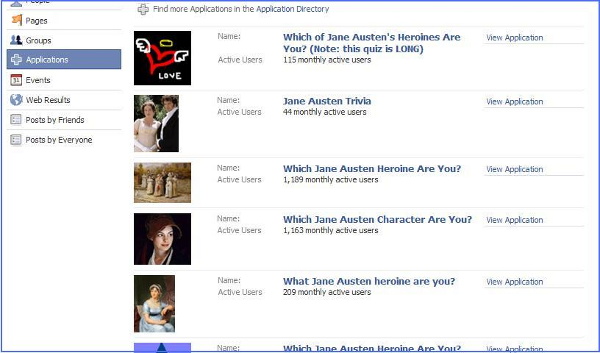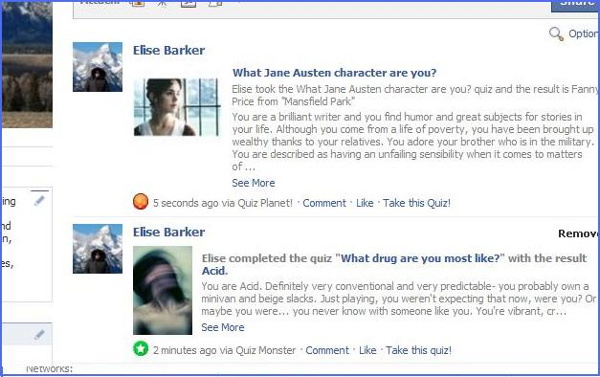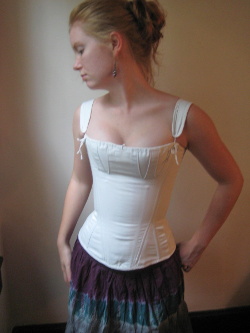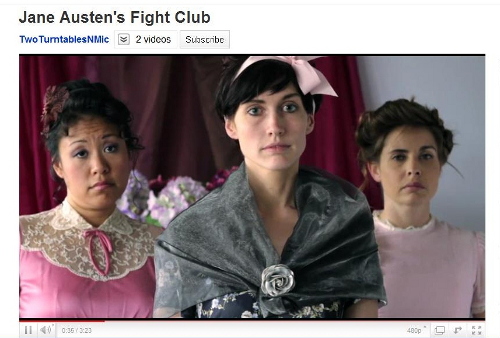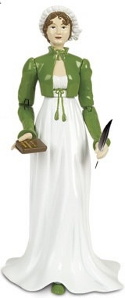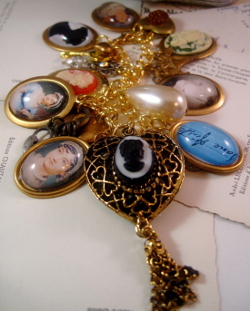|
A few years ago, my mom gave me a sweatshirt with the phrase “I ♥ Mr. Darcy” boldly printed across the chest. Since then I have found myself coming back to the question of what wearing the shirt says about my identity, as well as what the very existence of the sweatshirt says about Jane Austen, her works, and her legacy. Although aspects of famous artists, authors, and musicians are frequently made into commodities for sale in catalogues and gift-shops, the broad range of cultural artifacts inspired by Austen is staggering: board games, quilt patterns, action figures, film adaptations, critical works, fan-fiction, crafts, improvisational and theatrical groups, literary sequels, and online videos.
In “Trinkets and Treasures: Consuming Jane Austen,” Allison Thompson suggests that the various objects inspired by Austen are motivated by three different impulses: evocation, interaction through crafts, and irony. The evocative items range from Regency style wallpaper to lace parasols. Thompson explains that these items “act as talismans of the fan’s love for Austen and her wish to invoke the spirit of the author or to enable the fan to live as the author might have.” These items also “serve as a marker of actual or desired social class” and “appeal to the fan who wants to create a sense of historicity.” The second class of items that Thompson identifies are roughly characterized by their interactive quality; these items are handmade crafts and games that are inspired by Austen’s work, such as knitted shawls, needlework designs, and quilt patterns. Thompson points to the creative and intelligent thought undergirding the works: “Many crafter-fans . . . are creating three-dimensional theses on the nature of characterization.” Thompson’s third and final class of Austen-inspired items are ironic in nature. These range from finger puppets to underwear. What they share is a sense of postmodern irony: “Displayers of these items enjoy the contrast between the public perception that Austen is all about love and pretty dresses and the hip and ironic statements that the artifacts actually convey.”
My purpose in this paper is to extend Thompson’s analysis of Austen fan-produced and consumed cultural artifacts by examining the ways in which these products bolster the gendered identities of Austen fans. I also will explore how Austen is used and interpreted in very specific ways within popular culture, and even by very specific people (young women). While Jane Austen retains a great deal of cultural capital, one unfortunate side-effect of her popularity is that the general understanding of her work has also become increasingly narrow and gendered.
Beginnings: playfulness, identity, gender, and youth
Despite the differing purposes that consumers attach to their use of Austen-inspired products, one quality that many of these objects share is playfulness in tone. The production and consumption of Austen artifacts extends the reading experience beyond the act of reading in a way that mirrors children’s post-reading make-believe play, in which they act out and expand common stories and fables, trying out different personalities and extending the fictional world into a performative one.
Regardless of the lightheartedness associated with it, play is serious business. One of the most influential theorists on the purpose of play was Lev Vygotsky, who argued that “play was a result of social interaction, . . . and that play serves as the primary context for cognitive development” (Singer and Singer 28). More recently, researchers and theorists have begun to explore the ways in which play contributes to and constructs children’s social identity, especially as concerns race, gender and sexuality (Thorne; Fagot and Leve). Although adult play has not received as much scholarly attention, the area of study is growing. For instance, one expository paper on adult play by Lieselotte van Leeuwen and Diane Westwood utilizes the theories from an important theorist on childhood development, Donald Winnicott, to speculate that, similar to children’s play, adult play is “both identity production and culture making” (159).
Such studies suggest that the lighthearted tone underlying so many of the Austen-inspired products belies the real work that these artifacts do in the service of the Austen-fans’ identities. So, who are these fans? What traits do they have in common? In 2008, Jeanne Kiefer conducted a Janeite survey comprised of 4,501 people. Kiefer surveyed participants on fan websites and organizations, such as JASNA, AustenBlog, Yahoo/Janeites, and The Republic of Pemberley, therefore targeting fans and scholars who dedicate a good portion of their play-time to interacting with Jane Austen. Kiefer’s results showed more diversity than she was expecting. However, despite the diversity of Austen fans, 96% of respondents were female. Another surprising trend that Kiefer discovered in her survey is that the age that over half of the audience “fell in love with Austen” is a time in adolescence—17 and younger—when people are beginning to form an identity of their own as separate from their parents. Again, the evidence of this self-selected survey does not suggest that Austen’s readers share these traits but that her most deeply committed fans do, useful information for exploring the fan-related artifacts that I’m looking at here.
As we shall see, explorations of both youth culture and femininity are common in Austen-inspired fan-produced and consumed products; for this reason I am focusing on the “young women” subgroup of fans. And while play is certainly a kind of leisure activity, it also provides a space for self-discovery and a place to make sense of what social constructs like gender might mean to the individual, especially for adolescents and others in transitional states: Leeuwen and Westwood argue that adult play “may create the transitional space that would allow us to explore our position in society and to adapt accordingly as our social roles change across the lifespan” (159).
Austen as a piece in a bricolage: the process of identification online
One of the most literal forms of adult and adolescent play that we can observe among Austen-inspired products is the process by which many readers come to identify exclusively with a specific character from one of Austen’s books. Although identification with characters is habitually looked down upon by scholars as a limited and uncritical way of interacting with texts, it is often the primary means through which readers first enter the textual world. It is through identification that readers make meaningful connections between the literature they are reading and the real lives that they live.
An example of this practice can be seen on Facebook, an online social networking community that compiles user profiles. On Facebook, there are numerous “quiz” applications that, through a series of questions, purport to tell the quiz-taker, for instance, which Jane Austen character she is most like. After taking the quiz, the user can choose to display the results on her profile, thereby allowing her friends to see her results too. There are twenty-nine different Austen-related quizzes available on Facebook. According to one quiz, I was most like Marianne, another declared that I was Anne, and another was sure I was Lizzy. That said, had I really wanted to “be” Emma, I could have selected the answers that most resembled how she would react to a given situation and “got” her in the end.
The Facebook quiz illustrates that “playing” on the internet influences the development of a person’s social identity. The quiz reveals something to the user about herself through the abstract character traits associated with the chosen character. And because the quiz results can be posted on her profile, it allows the user to illustrate something about herself to the rest of the world. Therefore, the quiz provides an outward, social expression of identity, as well as an internal, subjective expression of identity. These two facets of identity are closely intertwined and form a dialectical relationship, something that is confirmed by the latest scholarship on the social implications of the internet. For instance, Weber and Mitchell explain that belonging to a social networking site is essentially a reflexive process, in which users’ “own media production . . . forces [them] to look at themselves, sometimes through new eyes, providing feedback for further modification of their self-representations” (41). Danah Boyd echoes this perspective: “Teenagers must determine where they want to be situated within the social world they see, then attempt to garner the reactions to their performances that match their vision. This is a lifelong process. (137)
Boyd’s reference to the process of identity at the end of this passage is worth lingering on. The Austen quiz results amount to a snippet in the vast amount of personal information amassed by Facebook users on their profiles. As soon as a user posts the result that she is a Fanny, she might go on to take a quiz that determines the drug that defines her is “acid.” Weber and Mitchell use the concept of bricolage—referring “to a construction or creation . . . that is improvised, using whatever materials at hand” (43)—in order to encapsulate the often contradictory nature of identity formation: “Like bricolage, identity construction involves improvising, experimenting, and blending genres, patching together contrasting or even contradictory elements, creating and modifying meanings to suit the context and in response to the requirements, affordances, and meanings of the situation” (43-44). Despite the fact that the Austen quiz—even all Austen-play—is only one small facet of identity construction, it remains significant that users grasp Austen characters as a means of figuring out even a small part of who they are.
Just like the me I want to be: Austen and alter egos
While the quiz tells the fan which character she is “most like,” the reality is that a quiz-taker is not really discovering her “essential self” through the quiz results, but instead, is exploring possibilities about the self: that self could be idealized, radicalized, or even villainized. This post-reading interaction with Austen’s characters resembles the way in which children act out stories, trying on the characteristics of their favorite characters, almost like a form of dress-up. And as Dorothy G. Singer and Jerome L. Singer explain, such responses to literature are a central feature of the reading experience: “Ordinary reading can influence one’s fantasy life to evolve into try-out alter-egos” (122). This observation is confirmed by Linda Christian-Smith’s extensive research into the multiplicity of reasons why women read romance fiction. She demonstrates that the girls and women in her study “derived pleasure from imagining themselves as the heroine of romance novels” despite the fact that their lives were nothing like those of the women portrayed in such novels (106). The research by Leary, Estrada and Allen on first-person and third-person avataric conceptions of the imaginary self confirms that the adoption of avatars or alter egos online, even in the transitory way reflected by the Facebook quiz, provides a moment wherein a fan imagines the vast possibilities of the self she might not have considered before (151-52).
No boys allowed? Identification, difference, and gender
Part of the appeal of an alter ego is the possibility of imagining the self as someone fundamentally different. However, one problem with character identification as the primary or exclusive means through which readers come to understand a novel is the fact that identity politics may make it difficult for some readers to commune or identify with a character who is different from the reader. While class, race and nationality certainly may interfere with the ability for one to identify with Austen’s characters, gender difference often creates the greater barrier. That gender identification divide may be problematic in the case of Austen’s characters because her novels feature and make central a great variety of heroines, not heroes. Anecdotally, while I have seen many of my girlfriends post “Which Jane Austen Character Are You?” quiz results on their profiles, I cannot recall one man who has done the same. Similarly, when I examined the quiz’s application page, I noticed that most of the people who have “liked” the quiz are women.
Men, of course, are not incapable of identifying with a woman character. But gender is often the first frame of reference for coming to understand a character. Certainly a character who is culturally similar to the reader in terms of age, class, gender, race, etc. will be easier for that reader to form an identification with, though it won’t necessarily be more instructive or exciting. Our first impulse is frequently to divide people along the lines of sex; indeed, Singer and Singer argue that such divisive behavior starts early and in the context of play: “The literature indicates that not only do children prefer to play with toys of the same-sex type, but same-gender children prefer to play with each other beginning as early as the toddler years” (42). When it comes to gender and literature among adolescents and even adults, the popular assumption is that boys and men will reject books written by and about women. Elizabeth Dutro suggests that this rejection is anticipated by boys’ realization “that things associated with girls and women are devalued and, thus, that it is important that they define themselves against these things. . . . Young boys quickly learn that one sure way of appearing ‘wimpish’ is to engage in activities that are associated with girls” (377). It is possible that boys and men are taking the Facebook quiz and are having avatar-like experiences with Austen’s characters but that they are refraining from posting the results on their profiles for the reasons that Dutro suggests: maybe for a man to post the result that he is “An Emma” is simply too close to saying that he is “A Woman.”
Thoroughly modern Lizzies: identifying “against” Austen characters
In any case, the idea that forming a playful association with a character of the opposite gender might be too much like saying one actually identifies as the opposite gender raises the question of how difference and sameness operate within identity construction. If men’s reluctance to feature the Austen quiz results on their profiles is an accurate indication, apparently having something in common with a character is helpful for achieving a sense of communion. However, the truth is that the tension between the two impulses—the desire for conformity and the desire for difference—is always present in identity-related practices because these conflicting desires continually implicate one another. Although fans certainly latch on to characters who resemble themselves (or at least who they want to be), the fact remains that Austen fans also respond to the difference between the characters’ lives and their own.
One of the most important general theories about identity construction is the way in which the “other” validates a person’s sense of self. We define ourselves against those people who are different from us and with those people who are similar to us. Describing some of Kenneth Burke’s theories and principles, C. Allen Carter explains that “[o]ur vocabularies develop relationally, that is, as fields of terms defined against each other; our identities, being formed of words, also develop as sets of terms defined against opposing sets of terms” (6).
For example, online discussions of Austen often include moments in which participants speculate about what was different “in those days.” One example of this pattern is on the Internet Movie Database (IMDb) message board for Ang Lee’s adaptation of Sense and Sensibility. The topic of the post is best summed up by its title: “Casting—Emma Thompson—too old?” Many respondents used the “in those days” argument to answer this question. Take, for instance, this post by zoerpit:
I think a slightly older actress is more realistic as we perceive it now. But I certainly wouldn’t have wanted to see her any older than Emma Thompson, . . . because . . . spinsters in their 30’s were frequently considered well past marriageable age in “polite” society in those days. (emphasis added)
The writer is essentially making an argument that tries to reconcile the realities of Regency England with the expectations of contemporary audiences.
The interest in the difference between “then and now” and the struggle to reconcile those differences, as zoerpit did above, is another way in which fans come to understand their own identities. Austen provides modern readers with a means of examining their own social identities by antithetical comparison to the characters in her novels because the nature of gender roles as portrayed within her books is often so fundamentally different from what we experience today. In the case of the film discussion, zoerpit is not only trying to make sense of marriage practices in Regency England, s/he is also making sense of marriage practices today, and the difference between the two throws their individual characteristics into relief. The minutiae dictating appropriate behavior in Regency England can help us first to recognize and then to understand our own practices, especially when those practices radically diverge.
For some consumers, it is possible that the fascination with differences in gender roles between then and now might be nostalgic in nature, especially for fans who like what Allison Thompson terms “evocative crafts.” The facade of clearly delineated social roles present in Austen’s work—at least as presented in some film adaptations of her work—might seem refreshingly simple, especially in a society where we now have to negotiate everything, especially gender roles. Indeed, as Sally Palmer reminds us, “A modern-day nostalgia for this kind of settled order [present in Austen’s novels], in fact, has been suggested as one of the reasons for the renaissance of Austen’s novels in the frenzied and chaotic 1990s.” However, the recent increase in Austen’s popularity is not fully encompassed by nostalgia. Brandy Foster explains, “Nostalgia seems to be an inadequate impetus for the explosion in Austen-related fiction, especially considering that several of the [recent film and literary] adaptations are set in America during the twentieth and twenty-first centuries, not in Regency England.”
Ambivalent modernity, nostalgia, and postmodern irony
My own investigation of Austen artifacts does not support the theory of nostalgia-impetus either. The relationship between nostalgia and fan identity is much more complicated, involving a give and take between nostalgia for the past and a clear sense that the fan is relieved to be a modern woman, with freedom to pick and choose a social identity that best expresses her own sense of self, not one dictated by rigid social roles.
Perhaps the best illustration of the ambivalence towards the specific manifestation of gender roles expressed in Austen’s work is the various pieces of Austen-inspired clothing available on Etsy.com. These clothes evoke Regency style, but at the same time remain thoroughly modern. “redthreaded,” the seller of this handmade “Marianne Corset,” describes the product in this way: “The pattern for this beautiful corset is based upon historical examples of corsets worn by women in Jane Austen's era, 1810-1825.” The creator clearly wants to evoke Regency style, and seems to have carefully recreated the corset with that style in mind. However, the presentation of the corset in the picture undercuts historicity of the product, because she has paired it with a broomstick skirt with a modern tie-dyed print, popular during the 1980s. This is a beautiful illustration of Weber and Mitchell’s conception of identity as bricolage: the seller has styled herself choosing from a variety of cultural tidbits and has not limited herself to a single cultural convention. Furthermore, as Inger Sigrun Brodey, one of the reviewers of this essay, pointed out, the “Marianne Corset,” a garment Austen would have considered to be underwear, appears to be intended to be worn in public, an aim that further destabilizes the possibility that fans like redthreaded are responding solely to a kind of nostalgia. This example illustrates how identity practices that operate through bricolage, with their intertextuality and lack of concern about paradox, are frequently accompanied by irony (usually intentional, but occasionally unintentional) as the fan both embraces nostalgia and its accompanying rigid performance of femininity and simultaneously denies it.
A more robust example of this dynamic might best be seen in the viral YouTube video “Jane Austen’s Fight Club,” an amateur-produced, artificial trailer for a “film” about Austen characters who create a fight club, à la Chuck Palahniuk. The characters create this club to escape a life that “had become an endless surrender to propriety.” On the one hand, the video features faux British accents, homemade “Regency” dresses, pretty props like tea cups and croquet sets, and surprisingly beautiful sets; in other words it is a kind of play that revels in nostalgia, a literal dress-up session. On the other hand, part of the fun of the video is the way in which the young actresses tear apart these precious nostalgic elements. The creators of this short film frame the descent of Austen’s characters into chaos around their rejection of gender roles, stating first in a resigned voiceover that “a lady had her duties, her expected accomplishments, her polite affections, and the primary objective to marry or, for all intents and purposes, perish,” and then implying that the fight club, by allowing the women to reject these roles, provides transcendence and growth.
Thompson argues that many Austen-related products function in ironic ways, providing fans with a short-hand means of discovering other Austen-fans in their midst. However, the postmodern, intertextual irony of artifacts like “Jane Austen’s Fight Club” should not be equated too simply with a traditional, Austenian use of irony. Lisa Colleta explains that postmodern irony assumes that meaning is contingent upon audience and context, and therefore, that meaning is never stable or fixed, which leads to a sense that the appearance of meaning is more important than meaning itself. Indeed, Colletta argues that “[t]he irony of postmodernity denies a difference between what is real and what is appearance and even embraces incoherence and lack of meaning” (856). A simple example of this meaninglessness can be found in fashion, where almost anything can be cool—even a gold lamé body suit—if it is worn ironically, with an attitude that suggests, “I’m wearing this because I actually hate it.” But the fascinating thing about irony in this form is that it allows the consumer to simultaneously reject and embrace that which she consumes. The question often becomes: does she really hate that body suit after all?
Take, for instance, the “Team Bennett” charm that I found on Etsy.com. This charm, provided by the seller “prettywhimsical,” evokes nostalgia through the image of the girl in classic Regency dress, which stylistically mimics the illustrations of Austen’s contemporaries. However, the phrase “Team Bennett” references the internet shorthand means of showing one’s allegiance in pop-culture debates by choosing a “team”: for example, “Team Coco” refers to the late-night network television battle between Conan O’Brian and Jay Leno for the Tonight Show time slot. This text, with its low-stakes pop-culture reference, subverts and denies the preciousness of the illustration. Nevertheless, the very presence of the illustration on the charm demonstrates that the wearer does embrace nostalgia. The charm provides an ironic distance that allows the fan to playfully embrace, explore, and perform within both modern and nostalgic modes without being fully committed to either.
My Jane: the mythic Austen as a vessel
The celebrated Jane Austen Action Figure clearly operates within the ironic mode: instead of the sword or a gun that traditionally accompanies such figurines, this action figure “comes with her famous writing desk and a removable quill pen” (Thompson), subtly underscoring the ironic incongruity within the “author as action-figure” premise. But the action figure denies a fixed or easy interpretation: underlying this ironic toy designed to elicit a good-natured laugh at Austen’s expense, there lurks a reverence for Austen and the familiar objects of her world. For instance, the inclusion of Austen’s “signature sloped desk” hearkens back to the famous and much quoted story in James Edward Austen-Leigh’s memoir, in which he explains that Austen wrote in the sitting room, a piece of blotting paper in hand to conceal her writing should a creaking door alert her to approaching visitors (Trumpener 146). That desk now resides in the British Library.
The story of the writing desk and the creaking door has come to be an emblem of women’s writing in general, and especially women’s writing historically, as Deirdre Lynch asserts in her introduction to the book Janeites (18). Although most modern women in the West are not faced with the same impediments that Austen and her contemporaries were, the story depicted in Austen-Leigh’s memoir is one that continues to resonate among female fans in particular. It reminds the fan that she lives in a world much more tolerant of female ambition. At the same time, the story provides encouragement to the fan: Austen was able to continue her work, despite the numerous barriers against her. Austen becomes a symbol of hope for young women with ambition, whatever their professional goals may be.
However, the veracity of Austen-Leigh’s story has been questioned in many contexts, certainly in its mis- or under-representation of Austen’s ambition. Perhaps it is the fact that Austen’s biography is so fraught with difficulties that the mythology associated with her has become so symbolic; we know just little enough about her for her to be a vessel for our own personal concerns. In any case, it is no wonder that numerous artifacts use her image in a way that resembles a talisman or mascot. This charm bracelet by “justbedesigns” is only one example among hundreds that use portraits of Jane Austen as a centerpiece. Like patron saint medals, this jewelry uses her as an icon, a vessel into which the individual reader can pour her own hopes and dreams. And like the patron saints who are known by their first names, Austen is “Jane.”
Just us girls: femininity, gender, and Austen
In addition to the iconic quality of the Jane Austen Bracelet of Charming Charms, it also immediately suggests femininity. The vintage cameos, flowers, hearts, and lockets are all symbols typically associated with femininity, fitting, considering that Jane Austen’s contemporary fanbase is mainly comprised of women. Here Jane Austen is drawn upon as a symbol, representing a woman who, through her writing, defies the gender roles of her time but who is, nevertheless, distinctly feminine. This Jane Austen is a model of the bricolage identity practices that girls can draw upon for inspiration.
However, as I have already suggested above, the femaleness of Austen fans is not without its costs to a judgment of Austen’s significance. The facts that many women read her and that so many of her die-hard fans are women establish her as a woman’s author, related to chick-lit or romance. Indeed, Juliette Wells illustrates that the writers within the chick-lit genre claim Austen as a kind of mother: “writers of chick lit . . . frequently invite us to view their works as descendants of women’s literary classics” (48). Additionally, Claire Harmon argues that “one of the horrible ironies of Austen’s currency in contemporary culture is that she is referenced so freely and confidently in discussions of ‘empowerment,’ ‘girl power,’ and all the other travesties of womanly self-fashioning that stand in for feminism in the present day” (205). The association between Austen and her “progeny,” chick-lit, contributes to a culture in which Austen is viewed more narrowly in terms of the ubiquitous contemporary women’s genres.
Further, the exclusivity of Austen’s female fanbase might also contribute to the ways in which Austen is being read in an increasingly narrow way. Associated with women’s genres like chick-lit and romance, her novels are being read in terms of the discourse conventions of those novels. Similarly, some readers discount her writing as “merely” about domestic concerns. A more complex example is that throughout this paper, I found myself having difficulty expressing the popular sentiments about Austen’s work when so often these sentiments are not entirely accurate. For instance, her work does not unambiguously reinforce rigid social roles, but it is often assumed that it does. Even in the case of the Facebook quiz discussed above, the characters lose their complexity in the way in which their traits are conveyed. See, for example, these results for Lizzy:
You are intelligent, loving and sociable. Your confident and dynamic character never lets you pass unnoticed. You are decisive and strong headed but also passionate and understanding. Sometimes you may be driven by prejudice but you are open minded and allow the facts to change your mind in the end. (Mela)
These attitudes reflect a narrowing in the way that we read Austen, and part of what might cause this narrowing of interpretation is that her readership latches on to certain aspects of her work—the romance plot, in particular—at the expense of others, such as biting social commentary and sophisticated irony.
Making room at the table: men and Jane Austen
That said, the classification of Austen as a writer for women has only recently become the norm. Indeed, Claudia Johnson points out that Janeites have often been men: “ in its most influential forms, the Janeitism of the early twentieth century was, with the prominent exception of Shakespeare scholar Caroline Spurgeon, principally a male enthusiasm shared among an elite corps of publishers, professors, and literati, such as Montague Summers, A. C. Bradley, Lord David Cecil, Sir Walter Raleigh, R. W. Chapman, and E. M. Forster” (30). Additionally, Kipling’s story “Janeites” attests to the fact that even as recent as World War I men were consuming Austen in a fan-like way. When I was doing research for this paper, however, I had to work to find examples of male-produced artifacts.
One example of a masculine artifact is “The Jane Austen Drinking Game” on YouTube, a live recorded performance of a comedy skit. This skit specifically addresses the issue of masculinity and Austen fandom. In this skit, the actors watch Sense and Sensibility, drinking only when one of the following appears in the film: inadequate dowry, small dogs, womanly skill, woman losing her countenance, retention of countenance, spontaneous equestrianism, falling in love, esteem and/or regard, and failure to observe rank. Part of the humor of this skit stems from the fact that as a culture we expect men to be dumbfounded by the concepts mentioned as drink-worthy here. Even knowledge about inadequate dowries and failure to observe rank, which aren’t particularly feminine topics, are often assumed to be part of the feminine realm, in part because they are associated with Austen, who is increasingly perceived as a writer for women.
How, then, did the relegation of Austen into the feminine realm happen? We can certainly look to the text for answers to that question. For instance, Harmon speculates that men may be put off by Austen’s “two-dimensional” “sexless” characterization of her male characters (202). Additionally, as I suggested in reference to the Facebook quiz, Austen’s novels focus on women and women’s concerns, potentially making it more difficult for men to identify with her characters in the same intimate way that women do. However, while these issues may contribute to the problem, Austen’s significant male fanbases in the past put this theory to rest as an absolute explanation. Appreciation of literature and author fandom is not contingent upon identification and identity.
Instead, I would argue that the kinds of playful artifacts I have been discussing contribute to the narrowing of how we read Austen, and it is precisely because these products are so loaded with feminine identity-making material that men might be uncomfortable joining in on the fandom fun. In other words, the materials for consumption associated with Austen that invite girls and women to explore their identities in fluid, creative and empowering ways—charm bracelets, corsets, quizzes designed to discover which heroine “you” are, “I ♥ Mr. Darcy” sweatshirts—are the same products that exclude heteronormative masculinity and tacitly create a culture of femininity around Austen. Even playfulness itself, which might be the feminine complement to the more masculine “leisure,” may contribute to a gendered reading of Austen.
In any case, whether the prevalence of feminine fan artifacts is a product of the 96% woman fandom or if that fandom is a product of the fan produced and consumed artifacts is ultimately unimportant. What is important is the way in which they reinforce one another and contribute to the prevalent assumption that Austen is not for men. I am not arguing that there is something wrong with the feminization of Austen-inspired play. I hope I’ve shown that these artifacts provide a creative space for girls and women to explore their identities. But perhaps we also need to find imaginative and respectful ways of reintroducing Austen to a new generation of male fans. Works Cited Boyd, Danah. “Why Youth ♥ Social Network Sites: The Role of Networked Publics in Teenage Social Life.” Youth, Identity, and Digital Media. Ed. David Buckingham. Cambridge: MIT P, 2008. 119-42. Carter, C. Allen. Kenneth Burke and the Scapegoat Process. Norman: U of Oklahoma P, 1996. Christian-Smith, Linda K. Becoming a Woman Through Romance. New York: Routledge, 1990. Colletta, Lisa. “Political Satire and Postmodern Irony in the Age of Stephen Colbert and Jon Stewart.” The Journal of Popular Culture 42 (2009): 856-74. Dutro, Elizabeth. “But That’s a Girl’s Book! Exploring Gender Boundaries in Children’s Reading Practices.” The Reading Teacher 55.4 (2001-02): 376-84. Fagot, Beverly, and Leslie Leve. “Gender Identity and Play.” Play From Birth to Twelve and Beyond: Contexts, Perspectives and Meanings. Ed. Doris Pronin Fromberg and Doris Bergen. New York: Routledge, 1998. 187-92. Foster, Brandy. “Pimp My Austen: The Commodification and Customization of Jane Austen.” Persuasions On-Line 29.1 (2008). Harman, Claire. Jane’s Fame: How Jane Austen Conquered the World. New York: Holt, 2009. “Jane Austen Action Figure.” Accoutrements. Web. 11 Nov. 2010 <accoutrements.com>. “Jane Austen Drinking Game.” YouTube. 17 Sept. 2008. Mostly Water Theatre: The Irrelevant Show. Web. 24 Nov. 2009 <youtube.com>. “Jane Austen’s Fight Club.” YouTube. 23 July 2010. Web. 15 Nov. 2010 <youtube.com>. Johnson, Claudia L. “The Divine Miss Jane: Jane Austen, Janeites, and the Discipline of Novel Studies.” Janeites: Austen’s Disciples and Devotees. Ed. Deidre Lynch. Princeton: PUP, 2000. 25-44. justbedesigns. “Jane Austen Bracelet of Charming Charms.” Etsy. Web. 24 Nov. 2009 < etsy.com/ >. Kiefer, Jeanne. “Anatomy of a Janeite: Results from The Jane Austen Survey 2008.” Persuasions On-Line 29.1 (2008). Leary, Mark, Marie-Joelle Estrada, and Ashley Batts Allen. “The Analogue-I and the Analogue-Me: The Avatars of the Self.” Self and Identity 8 (2009): 147-61. Leeuwen, Lieselotte van, and Diane Westwood. “Adult Play, Psychology and Design.” Digital Creativity 19.3 (2008): 153-61. Lynch, Deidre Shauna. “Sharing with Our Neighbors.” Janeites: Austen’s Disciples and Devotees. Ed. Deidre Lynch. Princeton: PUP, 2000. 3-24. Mela, Elmy. “Which Jane Austen Character Are You?” Facebook. Web. 10 Nov. 2010 <facebook.com>. Palmer, Sally. “Robbing the Roost: Reinventing Socialism in Diarmuid Lawrence’s Emma.” Persuasions On-Line Occasional Papers 3 (1999). prettywhimsical. “Scrabble Tile Art Pendant Team Bennett Charm plus Gift Tin” Etsy. Web. 24 Nov. 2009 <www.etsy.com>. redthreaded. “The Marianne Corset” Etsy. Web. 24 Nov. 2009 < etsy.com>. Singer, Dorothy G., and Jerome L. Singer. Imagination and Play in the Electronic Age. Cambridge: Harvard UP, 2005. Thompson, Allison. “Trinkets and Treasures: Consuming Jane Austen.” Persuasions On-Line 28.2 (2008) Thorne, Barrie. Gender Play: Girls and Boys in School. New Brunswick: Rutgers UP, 1994. Trumpener, Katie. “The Virago Jane Austen.” Janeites: Austen’s Disciples and Devotees. Ed. Deidre Lynch. Princeton: PUP, 2000. 140-65. Weber, Sandra, and Claudia Mitchell. “Imaging, Keyboarding, and Posting Identities: Young People and New Media Technology.” Youth, Identity, and Digital Media. Ed. David Buckingham. Cambridge: MIT P, 2008. 25-47. Wells, Juliette. “Mothers of Chick Lit? Women Writers, Readers, and Literary History.” Chick Lit: The New Woman’s Fiction. Ed. Suzanne Ferriss and Mallory Young. New York: Routledge, 2006. 47-70. Zoerpit. “Re: Casting—Emma Thompson—too old?” IMDb 23 Oct. 2008. Web. 24 Nov. 2009 <imdb.com>.
|


